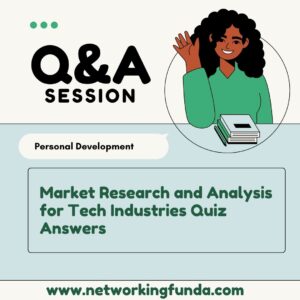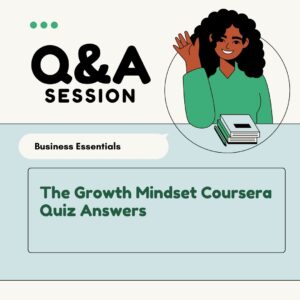All Weeks Entrepreneurship 1: Developing the Opportunity Quiz Answers
Table of Contents
Entrepreneurship 1: Developing the Opportunity Week 1 Quiz Answers
Quiz 1: Module 1: Introduction to Entrepreneurship Quiz
Q1. Select the statement about founders that is not true:
- Women start nearly 40% of businesses in the US
- Overconfidence increases the chance of launching a venture, but not the chance of success
- The average age for receiving venture capital is 42
- Founders in their 20s succeed at a higher rate than founders in their forties
Q2. What can accurately predict whether you will be a successful entrepreneur?
- Your personality
- Your level of confidence in your idea
- Your attitude towards entrepreneurship
- None of the options are true
Q3. The original iPhone was a(n) ____; the iPhone 6s was a(n) ____.
- Incremental innovation; discontinuous innovation
- Discontinuous innovation; radical innovation
- Radical innovation; discontinuous innovation
- Discontinuous innovation; incremental innovation
Q4. What is an example of established firms cultivating innovation through internal development?
- Sabbatical
- Separate R&D labs
- All answers are true
- Dedicated time for individuals (e.g. 20% time)
Q5. In 2014, high-tech small businesses (less than 250 employees) created __% of private sector jobs.
- 20-30%
- 30-40%
- 10-20%
- 0-10%
Q6. Impact entrepreneurs can scale through which of the following methods?
- Increase geographic reach through franchises
- All answers are true
- Partner with someone who has last-mile reach at scale
- Influence policy changes
Q7. The difference between intrapreneurs and entrepreneurs is:
- Entrepreneurs use bank loans to fund their business, intrapreneurs use venture capital
- Intrapreneurs want to start big businesses, entrepreneurs want to start small businesses
- Entrepreneurs launch their own businesses, intrapreneurs start businesses inside established companies
- Entrepreneurs want to start big businesses, intrapreneurs want to start small businesses
Q8. What is an effective strategy that would help overcome challenges associated with transitioning from the “ferment” to the “takeoff” period?
- Reduce entry cost for complementers to join your network
- Release a complementary product
- Develop a product that appeals to early adopters
- Compete in the largest market segment with the industry incumbent
Q9. During the beginning phase of an industry’s evolution, it is important for a company to control the ____ of its products. During the maturity/saturation phase, it is important for a company to control the ____ of its products.
- Complementary assets; uniqueness
- Market power; bargaining power
- Bargaining power; market power
- Uniqueness; complementary assets
Q10. How do social ventures differ from traditional ventures?
- It is easier for social ventures to scale
- Social ventures only focus on healthcare, sanitation, education, and energy sectors
- Social ventures focus on social and/or environmental impact, but not profits
- Traditional venture capital is often not an option for social ventures
Entrepreneurship 1: Developing the Opportunity Week 2 Quiz Answers
Quiz 1: Module 2: Opportunity Analysis Quiz
Q1. Which of the following categories of uncertainty has the lowest risk?
- Unknown risks
- Uncertainties
- Known facts
- Systematic risks
Q2. Which of the following is not a condition that has to hold in order to create value in innovation?
- The need has to be real
- The cost to deliver the solution must decline overtime
- The solution has to meet the need
- The customer has to be willing to pay more for the solution than the cost to deliver it
Q3. The “pull” approach to innovation starts with the ____; the “push” approach to innovation starts with the ____.
- Solution; need
- Need; solution
- Customer; product
- Product; customer
Q4. Which of the following is a common risk associated with the “push” approach to innovation?
- The cost to deliver the solution is not optimized
- The solution does not meet the need
- It fails to consider all possible solutions to the identified need
- This approach does not identify the need
Q5. Which of the following is an effective incentive for customers to participate in crowdsourcing?
- All answers are true
- Incentive to encourage a company to address their needs
- Monetary incentives
- Incentive to develop skills
Q6. What is a best practice to effectively extract customer ideas through crowdsourcing?
- Provide value to participants who do not win
- All answers are true
- Encourage a sense of community
- Provide an effective incentive structure
Q7. What are the three key variables in the VIDE model?
- Idea, Development, Exogenous factors
- Idea, Design, Execution
- Innovation, Development, Execution
- Internal factors, Development, External factors
Q8. What was concluded from the study of products on quirky.com?
- Marketing of a product is not an accurate predictor of sales rate
- Quality of idea is the best predictor of sales rate
- All answers are true
- Consumers themselves are the best single indicator of idea quality
Q9. What is a key criteria for assessing attractiveness of entrepreneurial opportunities?
- Gross margin
- All answers are true
- Significance of the need
- Effectiveness of the solution to address the need
Q10. A tournament where a large number of raw opportunities are generated, then a series of development steps are applied, and ultimately the exceptional opportunities are identified, is called:
- Idea tournament
- Survivor tournament
- Opportunity tournament
- Innovation tournament
Entrepreneurship 1: Developing the Opportunity Week 3 Quiz Answers
Quiz 1: Module 3: Markets, Need Finding and Planning Quiz
Q1. Which of the following is true:
- Early Adopters adopt technologies before Innovators
- Early Adopters have revolutionary needs, the Early Majority has evolutionary needs
- Early Adopters are the largest market segment
- Early Adopters buy products for the prestige of owning them
Q2. Which of the following describes the correct sequence of identifying customer needs through user research?
- (1) Establish relative importance of the needs (2) Gather raw data from customers (3) Interpret the data (4) Organize the needs by type
- (1) Gather raw data from customers (2) Interpret the data (3) Organize the needs by type (4) Establish relative importance of the needs
- (1) Interpret the data (2) Gather raw data from customers (3) Organize the needs by type (4) Establish relative importance of the needs
- (1) Gather raw data from customers (2) Interpret the data (3) Establish relative importance of the needs (4) Organize the needs by type
Q3. True or False? The marginal increase in percent of customer needs identified generally decreases as the number of one-on-one interviews increase
- True
- False
Q4. Which of the following is not a best practice during an interview aimed to understand customer needs?
- Ask about future behavior rather than current behavior
- Forget the product concept you have in mind and focus on user need
- Do not ask leading s
- Ask for specific examples rather than generalizations
Q5. Which of the following is not a tactic of “judo strategy”?
- Give a stake in the success of your company to would-be opponents to defray competitive threat
- Leverage strength in a niche market and engage in overt head-to-head competition
- Manage the transition from short to long term, initially operating below the radar and scaling-up later
- Develop a theory for why the incumbent will be reluctant to immediately compete aggressively
Q6. Which of the following best describes a “disruptive” entrepreneurial strategy?
- Working to undermine the industry’s existing value chain, usually via a competition strategy
- Creating new market spaces
- Working with others (cooperating) in a value chain to bring a product or service to market
- Developing new products to replace those of the incumbent
Q7. The most effective approach to idea generation is:
- Gathering as a group to discuss ideas openly
- Having individuals submit ideas anonymously, then evaluating submissions independently
- Electing a core committee to evaluate anonymous idea submissions
- Having individuals work independently, then gathering as a group to discuss ideas
Q8. When developing underlying assumptions involved in an entrepreneurial venture, what are the four key categories that assumptions fall into?
- (1) Organizational structure (2) Sales and operations (3) Customer segmentation (4) Financials and profits
- (1) Planning and operations (2) Staffing and hiring (3) Technology (4) Sales and marketing
- (1) Customer needs (2) Competition (3) Pricing (4) Partners
- (1) Customer value (2) Technology and operations (3) Sales and marketing (4) Financials and profits
Q9. Which of the following is not a step in Discovery Driven Planning?
- Identify customer segment
- Map the operational steps for your enterprise
- Benchmark assumptions
- Build a reverse income statement
Q10. Discovery Driven Planning can be a critical planning tool because it:
- All answers are true
- Forces you to think in terms of assumptions, and focus on reducing risk at the lowest cost
- Lets you test real numbers
- Gives you a quantitative tool for analyzing your enterprise
Entrepreneurship 1: Developing the Opportunity Week 4 Quiz Answers
Quiz 1: Module 4: Pitching, Testing and Prototype Quiz
Q1. Complete the two-sentence pitch: For the target audience who _____ the product name is a product category that offers a benefit. Unlike competitors or substitutes we _____.
- Wants to buy / Are different in a key way
- Has a need / Are different in a key way
- Has a need / Are priced differently
- Wants to buy / Are priced differently
Q2. What is a common downside of convenience samples compared to other survey methods:
- The sample group may not be representative of the population
- All answers are true
- They are expensive to collect
- It is difficult to generate enough interest for a large sample
Q3. Which of the following is a best practice when developing survey s?
- Only using Yes/No s to qualify/sort groups
- Including demographic s near the beginning of the survey
- All answers are important factors to consider when developing survey s
- Being careful with open-ended s
Q4. What is the best method to approach survey s on pricing/features?
- Pricing ladder
- Von Westendorp
- Conjoint analysis
- Open-ended s
Q5. What is the benefit of building prototypes?
- All answers are reasons for building prototypes
- They can prove that your solution is technically feasible
- They demonstrate that you can successfully implement the idea
- They communicate what you are doing to the marketplace
Q6. Which of the following is a disadvantage associated with the ODM (“original design manufacturer”) approach?
- Outsourcing the design work is costly
- The manufacturer does not have design expertise
- The outsourcing firm has nothing proprietary
- The outsourcing firm has little control over the end product
Q7. True or False? If your enterprise’s advantage comes from a unique, proprietary design, then it needs to own the design.
- True
- False
Q8. What is one advantage of throwaway prototyping?
- Only the features that are well understood are built and tested
- It is fast and provides users a full sense of the system
- It requires less technical expertise
- All answers are true
Q9. What type of prototype would be a good candidate for the initial prototype?
- Static and of low/medium fidelity
- Interactive and low/medium fidelity
- Static and of medium/high fidelity
- Interactive and medium/high fidelity
Q10. What is a characteristic of the “Wizard of Oz” approach to prototyping services?
- Consumer is unaware of the back end operations
- Consumer is only presented with one part of the service
- Half of the consumers are given one treatment and the other half are given a different treatment
- None of these are true
Get All Course Quiz Answers of Entrepreneurship Specialization
Entrepreneurship 1: Developing the Opportunity Quiz Answers
Entrepreneurship 2: Launching your Start-Up Quiz Answers
Entrepreneurship 3: Growth Strategies Coursera Quiz Answers
Entrepreneurship 4: Financing and Profitability Quiz Answers



